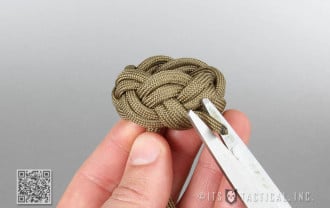Read more of this story at Slashdot.
Jay McDaniel
Shared posts
Most Americans Think Courts Are Failing To Limit Government Surveillance
SCR Screen Recorder for Android Captures High-Quality Screencasts
Android (4.0.3+, Rooted): Recording screencasts on Android can get a little tricky. Some apps only support certain devices, and all of them require root access. SCR Screen Recorder is one of the first that supports a broad array of devices, including Tegra-powered Android tablets like the Nexus 7.
Scan Items to Make Wall Mounting Them a Cinch

If you're mounting a power strip, router, or other small items to the wall, a quick scan and printout of the drill holes might save your sanity.
How to Protect Yourself from Apps that Make Wi-Fi Hacking Simple

It's not paranoia: Using public or open Wi-Fi networks without taking your security into consideration is a bad idea. You don't even have to crack the network's passwords to grab tons of data from unsuspecting users on the network—We've shown you how to do it, and how to stop it from happening to you. Now, dSploit, a security toolkit for Android, makes that process so simple anyone can do it. Here's how it works, and how to protect yourself.
Manually Adjust Netflix Streaming Options With Hidden Settings

If you have a decent connection, Netflix does a pretty good job of automatically calibrating streaming options. However, for slower connections, you can choose to lower the streaming rate with a secret settings menu.
LG outs diminutive Bluetooth headset with 8 hours of battery life
LG's big ticket items may take up most of our attention span, but the South Korean firm's latest Bluetooth headset solution has caught our eye. Coming in at roughly the size of a matchbox (35.9 × 50.2 × 19.2mm), the BTS1 boasts an 8 hour battery life, features a built-in clip, supports the aptX codec and packs on-board controls for volume, pause and play, sifting through songs and handling phone calls. With the help of Bluetooth 3.0, the pack connects to smartphones, laptops, tablets and even TVs -- yes, even those in LG's 2013 line-up -- with the wireless standard baked in. Of course, you could always lean on a Roku 3 if you're hankering for a wire-free television experience for your earbuds. There's no word of a US release, but if you find yourself in PSY's homeland, you'll be able to score one for 59,000 won (roughly $53).
Filed under: Portable Audio/Video, HD, Mobile, LG
Source: LG (translated), LG (Flickr)
Lavabit Encrypted Email Service Shuts Down, Can’t Say Why
Lavabit announced today that it would shut down its encrypted email service rather than “become complicit in crimes against the American people.” Lavabit did not say what it had been asked to do, only that it was legally prohibited from sharing the events leading to its decision.
Lavabit was an email provider, apparently used by Edward Snowden along with other privacy sensitive users, with an avowed mission to offer an “e-mail service that never sacrifices privacy for profits” and promised to “only release private information if legally compelled by the courts in accordance with the United States Constitution.” It backed up this claim by encrypting all emails on Lavabit servers such that Lavabit did not have the ability to access a user's email (Lavabit’s white paper), at least without that user's passphrase, which the email provider did not store.
Given the impressive powers of the government to obtain emails and records from service providers, both with and without legal authority, it is encouraging to see service providers take steps to limit their ability to access user data, as Lavabit had done.
But now it’s gone. Here is Lavabit's statement in full:
My Fellow Users,
I have been forced to make a difficult decision: to become complicit in crimes against the American people or walk away from nearly ten years of hard work by shutting down Lavabit. After significant soul searching, I have decided to suspend operations. I wish that I could legally share with you the events that led to my decision. I cannot. I feel you deserve to know what’s going on--the first amendment is supposed to guarantee me the freedom to speak out in situations like this. Unfortunately, Congress has passed laws that say otherwise. As things currently stand, I cannot share my experiences over the last six weeks, even though I have twice made the appropriate requests.
What’s going to happen now? We’ve already started preparing the paperwork needed to continue to fight for the Constitution in the Fourth Circuit Court of Appeals. A favorable decision would allow me resurrect Lavabit as an American company.
This experience has taught me one very important lesson: without congressional action or a strong judicial precedent, I would _strongly_ recommend against anyone trusting their private data to a company with physical ties to the United States.
Sincerely,
Ladar Levison
Owner and Operator, Lavabit LLC
Defending the constitution is expensive! Help us by donating to the Lavabit Legal Defense Fund here.
It’s rare to see an email provider choose to go out of business rather than compromise its values. It must have been a hard decision for Ladar Levison, but he remained true to his promise to put privacy before profits. It was also hard on the users, some of whom lost access to email not available elsewhere.
Lavabit's ominous note and the lack of information about this case is especially concerning for users of large communication service providers like Facebook and Google that may well have been subject to similar pressure, and we hope they will continue to fight for the user in the face of government demands, even if not recognized for years. Already, Lavabit's note has led to Silent Circle dropping its email service, saying "We see the writing [on] the wall, and we have decided that it is best for us to shut down Silent Mail now. We have not received subpoenas, warrants, security letters, or anything else by any government, and this is why we are acting now."
Moving forward, we need more transparency so the public can know and understand what led to a ten-year-old business closing its doors and a new start-up abandoning a business opportunity. Hopefully Congress will get concerned, especially when there are American jobs at stake.
Lavabit’s post indicates that there was a gag order, and that there is an ongoing appeal before the Fourth Circuit. We call on the government and the courts to unseal enough of the docket to allow, at a minimum, the public to know the legal authority asserted, both for the gag and the substance, and give Lavabit the breathing room to participate in the vibrant and critical public debates on the extent of email privacy in an age of warrantless bulk surveillance by the NSA.
DEA and NSA Team Up to Share Intelligence, Leading to Secret Use of Surveillance in Ordinary Investigations
UPDATE: Add the IRS to the list of federal agencies obtaining information from NSA surveillance. Reuters reports that the IRS got intelligence tips from DEA's secret unit (SOD) and were also told to cover up the source of that information by coming up with their own independent leads to recreate the information obtained from SOD. So that makes two levels of deception: SOD hiding the fact it got intelligence from the NSA and the IRS hiding the fact it got information from SOD. Even worse, there's a suggestion that the Justice Department (DOJ) "closely guards the information provided by SOD with strict oversight," shedding doubt into the effectiveness of DOJ earlier announced efforts to investigate the program.
A startling new Reuters story shows one of the biggest dangers of the surveillance state: the unquenchable thirst for access to the NSA's trove of information by other law enforcement agencies.
As the NSA scoops up phone records and other forms of electronic evidence while investigating national security and terrorism leads, they turn over "tips" to a division of the Drug Enforcement Agency ("DEA") known as the Special Operations Division ("SOD"). FISA surveillance was originally supposed to be used only in certain specific, authorized national security investigations, but information sharing rules implemented after 9/11 allows the NSA to hand over information to traditional domestic law-enforcement agencies, without any connection to terrorism or national security investigations.
But instead of being truthful with criminal defendants, judges, and even prosecutors about where the information came from, DEA agents are reportedly obscuring the source of these tips. For example, a law enforcement agent could receive a tip from SOD—which SOD, in turn, got from the NSA—to look for a specific car at a certain place. But instead of relying solely on that tip, the agent would be instructed to find his or her own reason to stop and search the car. Agents are directed to keep SOD under wraps and not mention it in "investigative reports, affidavits, discussions with prosecutors and courtroom testimony," according to Reuters.
"Parallel construction" is really intelligence laundering
The government calls the practice "parallel construction," but deciphering their double speak, the practice should really be known as "intelligence laundering." This deception and dishonesty raises a host of serious legal problems.
First, the SOD's insulation from even judges and prosecutors stops federal courts from assessing the constitutionality of the government's surveillance practices. Last year, Solicitor General Donald Verilli told the Supreme Court that a group of lawyers, journalists and human rights advocates who regularly communicate with targets of NSA wiretapping under the FISA Amendments Act (FAA) had no standing to challenge the constitutionality of that surveillance. But Verrilli said that if the government wanted to use FAA evidence in a criminal prosecution, the source of the information would have to be disclosed. When the Supreme Court eventually ruled in the government's favor, finding the plaintiffs had no standing, it justified its holding by noting the government's concession that it would inform litigants when FAA evidence was being used against them.
Although the government has been initially slow to follow up on Verrilli's promises, it has begrudgingly acknowledged its obligation to disclose when it uses the FAA to obtain evidence against criminal defendants. Just last week DOJ informed a federal court in Miami that it was required to disclose when FAA evidence was used to build a terrorism case against a criminal defendant.
Terrorism cases make up a very small portion of the total number of criminal cases brought by the federal government, counting for just 0.4 percent of all criminal cases brought by all U.S. Attorney offices across the country in 2012. Drug cases, on the other hand, made up 20 percent of all federal criminal cases filed in 2012, the second most prosecuted type of crime after immigration cases. If the government acknowledges it has to disclose when FAA evidence has been used to make a drug case—even if it's a tip leading to a pretextual traffic stop—the number of challenges to FAA evidence will increase dramatically.
SOD bypasses the Constitution
Even beyond the larger systemic problem of insulating NSA surveillance from judicial review, criminal defendants whose arrest or case is built upon FISA evidence are now deprived of their right to examine and challenge the evidence used against them.
Taken together, the Fifth and Sixth Amendments guarantee a criminal defendant a meaningful opportunity to present a defense and challenge the government's case. But this intelligence laundering deprives defendants of these important constitutional protections. It makes it harder for prosecutors to comply with their ethical obligation under Brady v. Maryland to disclose any exculpatory or favorable evidence to the defense—an obligation that extends to disclosing evidence bearing on the reliability of a government witness. Hiding the source of information used by the government to initiate an investigation or make an arrest means defendants are deprived of the opportunity to challenge the accuracy or veracity of the government's investigation, let alone seek out favorable evidence in the government's possession.
Courts must have all the facts
The third major legal problem is that the practice suggests DEA agents are misleading the courts. Wiretaps, search warrants, and other forms of surveillance authorizations require law enforcement to go to a judge and lay out the facts that support the request. The court's function is to scrutinize the facts to determine the appropriate legal standard has been met based on truthful, reliable evidence. So, for example, if the government is using evidence gathered from an informant to support its request for a search warrant, it has to establish to the court that the informant is reliable and trustworthy so that the court can be convinced there is probable cause to support the search. But when law enforcement omits integral facts—like the source of a tip used to make an arrest—the court is deprived of the opportunity to fulfill its traditional role and searches are signed off without the full knowledge of the court.
Ultimately, if you build it, they will come. There's no doubt that once word got out about the breadth of data the NSA was collecting and storing, other law enforcement agencies would want to get their hands in the digital cookie jar. In fact, the New York Times reported on Sunday that other agencies have tried to get information from the NSA to "curb drug trafficking, cyberattacks, money laundering, counterfeiting and even copyright infringement."
Teaming up to play fast and loose with criminal defendants and the court, the DEA and NSA have made a mockery of the rule of law and the legal frameworks intended to curb abuses.
Google: Keep Android Users' Secure Network Passwords Secure
If you have a recent Android phone or tablet, chances are you take advantage of a convenient feature to backup your application settings and wireless network passwords. This feature is enabled by default in Android 2.2 and later, and it can make switching to a new device or replacing a lost phone a quicker process. If you haven't examined all the settings for your phone, you might not know if this setting is enabled.
You might not even know who has access to your data.

When a Google user sets up a new Android device with Google Play and signs into her Google account, Android Backup Service automatically downloads any backed up settings and wireless network passwords from Google's servers. All that is required of the user to begin this process is her Google credentials.
This indicates that the data is stored either in plaintext, or encrypted using Google account credentials only. In the latter case, it would need to be decrypted before transit to the user's device. However, a statement from Google to Ars Technica indicates that the former might be the case:
"Our optional 'Backup my data' feature makes it easier to switch to a new Android device by using your Google Account and password to restore some of your previous settings. This helps you avoid the hassle of setting up a new device from scratch. At any point, you can disable this feature, which will cause data to be erased. This data is encrypted in transit, accessible only when the user has an authenticated connection to Google and stored at Google data centers, which have strong protections against digital and physical attacks."
This statement makes clear that the data is encrypted in transit, which is good. But it doesn't say that the data is encrypted at rest. If it's not, authorized Google employees could access it or make it available to government data requests. We hope that Google is storing this data in an encrypted form such that only the user can unlock it.
How sensitive is this data? Settings data is generally limited to the options you select when configuring your device. It may also include a list of software you have downloaded from the Google Play Store.
Your wireless network passwords might be considered very sensitive. While you personally might not be too worried about sharing the encryption key for your home network, your employer might feel differently. In either case, since the network administrator has made the decision to secure the network, any developer designing software to store the network password should respect that decision and assume that the password wasn't meant to be left lying around in plain sight or plaintext.
Fixing the flaw is more complicated than it might seem. Android is an open source operating system developed by Google. Android Backup Service is a proprietary service offered by Google, which runs on Android. Anyone can write new code for Android, but only Google can change the Android Backup Service.
Google already has a great model for this kind of service in Chrome. Chrome's sync service allows a user to store all her settings on Google's servers, encrypted. By default, the data is encrypted with her Google credentials, but Chrome offers the additional option to encrypt this data with the user's own sync passphrase. This model would work very well for Android Backup Service.

Additionally, the open source Android OS itself could offer client side encryption as part of the backup code that Android Backup Service is built on. That way, third-party providers could more easily safeguard your data.
Cloud storage of personal data has become a ubiquitous part of the computing landscape, and of our daily lives. With frequent revelations of government, corporate, and entirely unauthorized abuse of that personal data, it's important to examine what we give to cloud providers, when, and how. The standard we'd like to see providers move toward is host-proof hosting, especially when backing up sensitive data. It might be reasonable to trust these companies at times in order to take advantage of the convenience their services offer, but trusting a service that mishandles one's data by failing to properly secure it is clearly a mistake.
Google says, "You should only give your WiFi password to people you trust." If Google has mapped our wireless networks and stored their passwords, they need to act fast to restore that trust.

What Should, and Should Not, Be in NSA Surveillance Reform Legislation
Following a wave of polls showing a remarkable turn of public opinion, Congress has finally gotten serious about bringing limits, transparency and oversight to the NSA’s mass surveillance apparatus aimed at Americans.
While we still believe that the best first step is a modern Church Committee, an independent, public investigation and accounting of the government’s surveillance programs that affect Americans, members of Congress seem determined to try to enact fixes now. Almost a dozen bills have already been introduced or will be introduced in the coming weeks.
While we’re also waiting to see what the various bills will look like before endorsing anything, here’s—in broad strokes—what we’d like to see, and what should be avoided or opposed as a false response. We know full well that the devil is in the details when it comes to legislation, so these are not set in stone and they aren’t exhaustive. But as the debate continues in Congress, here are some key guideposts.
This first post focuses on surveillance law reform. In later posts we’ll discuss transparency, secret law and the FISA Court as well as other topics raised by the ongoing disclosures. In short, there's much Congress can and should do here, but we also need to be on the lookout for phony measures dressed as reform that either don't fix things or take us backwards.
Patriot Act and FISA Amendments Act Reform
—Stop Bulk Collection. The starting point for NSA reform would be a definitive statement that court orders for bulk collection of information are not allowed and indeed are illegal. At all times, a specific person or specific identifier (like a phone number or email address) or a reasonable, small and well-cabined category (like a group on the terrorist list or member of a foreign spy service) must be specified in the context of an investigation. And a category like: “all records of all Verizon customers,” is neither reasonable, small nor well-cabined.
—Limits on Hops. Clarification that if one identified person is under investigation, the NSA does not have the authority to run analysis of call records on persons “two hops” or “three hops” away from that person without a separate court authorization.
—Metadata Protection. Information about communications, also called metadata or noncontent, requires probable cause warrants issued by a court (or the equivalent) whenever it reveals previously nonpublic information about or comprising your communications. This includes revealing your identity if it is not public, what websites you visit and information you read, who you communicate with, when, from where, and for how long. Public metadata information, such as information about Facebook wall posts, public tweets and followers or information available in telephone books or similar resources should not be included in this requirement. This is also contained in the International Principles on the Application of Human Rights to Communications Surveillance that applies international human rights principles to the digital age that EFF and hundreds of NGOs around the world have recently endorsed.
—Location Information. Metadata about your location, including cell phone GPS data, IP addresses and cell tower information should also require a probable cause warrant. The NSA claims the legal authority to collect this information on Americans in mass quantities as well, but claims they do not do so, but Senator Wyden indicates that this might not be the whole story.
—Congressional Disfavor of Third-Party or Business Records Doctrine. Eliminate the so-called third-party or business records doctrine. The fact that communications or communications records are held, collected or generated by third parties should be irrelevant to their protection under privacy statutes. Congress should also state firmly that the fact of third party involvement should be irrelevant to a person’s "reasonable expectation of privacy," as this may assist the courts when considering Fourth Amendment implications.
—Americans Protected Even if Communicating with a “Target.” Confirm the NSA must obtain a specific, probable cause warrant to seize or search Americans’ communications when they are picked up via a FISA court order or otherwise even if the American is not the “target” of the order. Often while the “target” of orders are foreign, American communications are vacuumed up and able to be searched thereafter without a warrant.
—U.S. Law Protects All Data in the U.S. Ensure that the protections of American law, including standing to sue to challenge violations of law, apply to all data accessed by the NSA in the United States, even if the data is about a non-U.S. person. This can help American businesses by assuring foreigners that they may use U.S.-based communications services without discrimination and will enjoy the same rights as U.S. persons when the government comes knocking.
—Legal Protections Start with Any Government Access. Confirmation that the legal protections start when the government has any access to the information under the Wiretap Act, FISA and other laws. The NSA has claimed at various times that the legal protections do not start until a human reviews the information or when it is "processed" or otherwise prepared for human review, thus excluding any legal protections against collection, storing and even apparently many kinds of analysis done by computers. This gamesmanship should end.
—Seizures or Searches Done With Technological Assistance Still Count. Confirm that seizures and searches done by computers are “seizures and searches” for purposes of the Fourth Amendment and search and seizure laws. Again the government seems to be taking the position that only human review counts, and that's not sensible, right or sufficiently protective of Americans. The use of technology to do what humans used to do, only faster, more efficiently and likely more accurately, shouldn’t change the level of protections that Americans enjoy in their communications and communications records.
-Information Gathered for National Security Purposes Cannot be Used for Other Purposes. Completely unsurprisingly, news is now starting to come out about use of the NSA collected information for ordinary criminal prosecutions completely unrelated to national security or terrorism. Congress must make this illegal and grant standing and severe sanctions to anyone whose data is misused in this way.
Confirm Public, Adversarial, Federal Court Role
—State Secrets Reform. State Secrets reform that resembles the late Sen. Kennedy’s proposal from 2008. The government has tried to use the state secrets privilege to dismiss EFF’s multiple lawsuits challenging the NSA, as well as those of many others, despite the fact there are hundreds of pages of public evidence documenting unconstitutional actions.
—Public, Adversarial Courts Must Determine if Surveillance is lawful. Confirmation that federal courts are clearly allowed to hear challenges to illegal surveillance, no matter if the government considers it “classified” or not. Security procedures like those outlined in 50 U.S.C. 1806(f) may apply, but the courts must always be able to determine whether the surveillance was lawful.
—Standing. Standing must be granted for those who have a well-founded fear of surveillance in language that will fix the problem that was identified by the Supreme Court in Clapper v. Amnesty.
—Reform Sovereign Immunity. Remove sovereign immunity provisions in the FISA Amendments Act to more clearly allow plaintiffs to stop unconstitutional programs, obtain injunctions and seek damages free of the FTCA.
—Confirm FISA Procedures for National Security Evidence. Confirm that 1806(f) plainly applies to all claims for illegal surveillance, not just FISA ones and including constitutional ones. 1806(f) is a provision in FISA that overrides the state secrets privilege.
PHONY “REFORMS” TO RESIST
Just as important as ensuring good reforms is resisting phony or bad ones. Here are a couple that we will be watching for as the debate continues.
—Data Retention. A “compromise” has recently been floated by several members of Congress that instead of the NSA holding onto phone records for five years, the phone companies should do it themselves, without limiting NSA access capabilities. Even NSA critics like Sen. Mark Udall have suggested this be a solution. The US currently has no data retention laws, but companies often keep information on customers for months or years at a time. Creating logs as a way to “solve” the NSA’s access problem is no solution—indeed it ignores the problem that the NSA has bulk access in the first place.
Congress has tried to pass flawed data retention legislation before, most recently by SOPA author Rep. Lamar Smith, but it was abandoned after protest from the Internet community that it would violate users privacy. Data retention laws create a honeypot of sensitive data available to malicious hackers, or accidental disclosures. But most importantly, the problem isn’t that the NSA has custody of the information, it’s that it has access to the information in bulk. Shifting custody without limiting access does nothing.
—CALEA II or Internet Backdoors. This has not yet been floated, as far as we know, but any effort to reform the law in light of the NSA surveillance must not itself require that communications companies increase the surveillance capabilities of their systems. The FBI has been secretly lobbying for years for an update to Communications Assistance for Law Enforcement Act (CALEA), which would essentially force large internet companies to build a backdoor into their systems so the feds could more easily get real-time access to communications. Given the level of distrust users have had with Internet companies after their involvement in the PRISM program with the NSA, this bill should be permanently shelved, instead of being part of any sort of compromise reform bill relating to the NSA. As we’ve explained before, this bill would not only make Internet communications less private, it would inhibit innovation and make the Internet less secure as well.
Marine Corps Commandant Accused of Improper Classification
Marine Corps Commandant Gen. James Amos exercised “unlawful command influence” in an attempt to punish Marines who allegedly urinated on enemy corpses in Afghanistan in 2011, attorneys for the Marine defendants said. And then Gen. Amos improperly classified information in an effort to conceal his own misconduct, the attorneys said.
“The evidence shows that the CMC [Commandant, Marine Corps] could not resist the temptation and decided to further the concealment of his unlawful intentions by ordering…, without proper authority or basis, the imposition of a secret classification upon the testimony and materials disclosed by the previously unclassified investigations of the alleged desecration cases,” defense attorneys said in a motion filed last week.
It’s a sordid story all around. What makes it interesting here is that a Marine Corps official warned in 2012 that the classification action was a mistake that could backfire against the Marine Corps if it ever became public.
“If this goes to the next level of administration or judicial action, there are some additional considerations that a lawyer, versed in classification issues, might be able to use to shoot holes in our whole process and bring the whole decision making process into question,” wrote William Potts in an internal email quoted in last week’s motion.
Improbably enough, he then cited the FAS Project on Government Secrecy and me (at page 19). A potential court-martial of the defendants would “spread us all over the media; would probably get Steven Aftergood, Project on Government Secrecy, involved…. He’d make us look silly if he supported a defense contention that the video was improperly classified.”
There is a creaky old saying to the effect that you should not do (or say or write or email) anything “if you wouldn’t want to see it on the front page of the Washington Post.” A similar principle might be applicable in the world of national security classification. If you couldn’t justify the classification of information to an outside reviewer, then you probably shouldn’t classify it.
Unfortunately, in the normal course of business, there are few occasions on which any official is ever called upon to justify his classification action to an impartial, independent observer. That’s just not the way the classification system is currently structured. But it could be. Increasing the number of opportunities for independently evaluating classification actions would quickly serve to improve the quality and legitimacy of classification activity.
For more background on the Marine Corps case, see these stories in Military Times and CNN.
The post Marine Corps Commandant Accused of Improper Classification appears on Secrecy News from the FAS Project on Government Secrecy.
Law Enforcement Wants To Weaken Section 230: What Could Possibly Go Wrong?
Via the ACLU I see that the Attorneys General of several states are asking Congress to weaken Section 230 of the Communications Decency Act.
Section 230 — which we have lauded here before — is crucial to freedom of expression on the internet. It gives broad immunity (with the exception of copyright and federal criminal law) to blogs, forums, news services, and other web sites for comments or other content left by visitors. Thanks to Section 230, I can't be sued for what you say in the comments to this post. Absent Section 230, I would have to police my comments for potential defamation and potential violation of the laws of a thousand jurisdictions.
As the ACLU reports, several Attorneys General want to weaken Section 230 to create an exception for any federal or state statute. Their justification, not surprisingly, is Think of the Children! — specifically, the children who are victims of sex trafficking. The state Attorneys General do not explain why it is necessary to create an exception encompassing all state laws on whatever subject in order to address child sex trafficking.
What could possibly go wrong?
I mean, sure, this means that the proprietors of web sites can be prosecuted if one of their commenters says something that local police construe as a threat — as in the case of Justin Carter, prosecuted and jailed and stuck in solitary confinement for a stupid but clearly non-serious rhetorical flourish about an online game.
And, sure, some police departments think that satire is "cyberstalking," like the Renton Police Department, which sought search warrants to investigate cartoons making fun of the police. Sure, under the language sought by the Attorneys General, the police could pursue the hosts of such satire as well as the content-creators.
And sure, all sorts of local jurisdictions — and even states — have vague, broad laws forbidding speech, such as speech by electronic means that "annoys, ridicules, and disparages." Sure, blogs and forums and other sites could become criminally liable under those laws for the actions of their commenters.
And sure, some states have criminal defamation statutes, and on occasion some prosecutors have fallen so far as to obtain search warrants to investigate clearly satirical blogs. Sure, the Attorneys General plan would make that more likely.
Sure, some cops have a very broad view of what constitutes "harassment" and a willingness to use their power to threaten people who, for instance, leave negative Yelp reviews. Sure, the Attorneys General plan would let them threaten web sites as well as users.
And sure, courts across the country occasionally impose patently unconstitutional protective orders forbidding people from writing about specified subjects at all; under the regime proposed by the Attorneys General, web sites might be held liable for contempt along with their users if they allowed a user to address a subject in violation of such an abusive order.
And sure, under the Attorneys General plan, I will have to evaluate each demand or threat from local authorities across the United States, evaluate the laws of distant and unfamiliar jurisdictions, consider how judges and juries of other states might view me of my commenters leave disfavored speech, and risk financial ruin. Sure, the most rational response will often be to simply yield to criminal threats — whether from police or even from individuals threatening to make reports to police — rather than face criminal consequences to provide a forum for free expression. Sure, risk-adverse companies will be particularly likely to yield to threats.
But surely we can trust state and local law enforcement to wield this power responsibly, right?
I mean, sure, prosecutors are largely immune to any consequences for misconduct, and police use whatever tools available to them to attack expression they don't like. But we can trust law enforcement.
Can't we?
Law Enforcement Wants To Weaken Section 230: What Could Possibly Go Wrong? © 2007-2013 by the authors of Popehat. This feed is for personal, non-commercial use only. Using this feed on any other site is a copyright violation. No scraping.
Rotolight Tries To Unring The Censorious Bell
Rotolight makes photography lighting systems; Den Lennie discusses and reviews them. Den Lennie posted a video review of a Rotolight product on Vimeo. Rotolight thought it was misleading and unfair. So Rotolight left comments explaining their point of view and posted a rebuttal on their website and publicized it through social media.
No, wait. That's the way a rational and honest company would handle it. No, Rotolight got the review taken down with a fraudulent DMCA copyright violation notice, as discussed here and here and here and here. Den Lennie got the takedown notice. When Lennie wrote about it, Rotolight showed up to, in effect, confess that it had made a bogus DMCA demand because it thought the review was unfair, and to assert a very stupid trademark argument:
The DMCA notice was utterly, preposterously bogus for many reasons others smarter than I have already pointed out. The DMCA doesn't even apply to trademarks (as opposed to copyright), and even if it did, a product review can name the product without violating its trademark.
Rotolight is now experiencing the Streisand Effect, and has posted a statement on its website. The statement is part apology, part justification, and part evasion. Rotolight complains that the review was inaccurate because it depicted a unit that had since been repaired to correct a problem. They apologize for a "breakdown in communication," offer to give Den Lennie's F-Stop Academy a very expensive free device, and make many of the right corporate-rehabilitation-tour noises.
But Rotolight's explanation for what happened falls far short. It claims:
In this specific case, the video was not removed for copyright infringement reasons as has been widely reported. Rotolight received external advice with respect to this particular video that it was potentially misleading and unrepresentative. This advice resulted in the only request the company has made to have a video removed from any video sharing website in the last 3 years.
This makes no sense. Is Rotolight saying that they didn't send a DMCA notice, and Vimeo is lying? If so, why don't they say so, and release what they actually sent? Otherwise, if it wasn't a copyright issue, why did Rotolight use the DMCA? If Rotolight had an objection to a review being "misleading and unrepresentative," why did they use a mechanism that required them to assert copyright infringement and affirm a statement that said "I swear, under penalty of perjury, that the information in the notification is accurate and that I am the copyright owner or am authorized to act on behalf of the owner of an exclusive right that is allegedly infringed"? You say that you got "external advice" that the video was misleading, but carefully avoid saying you got advice to use the DMCA as a mechanism to attack it — did you or didn't you? If so, who gave you that idiotic advice? Oh — and if this was about an inaccurate review, why did Rotolight leave a comment on Den Lennie's post making a fatuous trademark argument?
Rotolight pleads with its detractors to think of its employees, saying that a bad review can hurt:
It is important to understand the damage that can be caused not just to our business, but to its hard working employees and their families, and also to the numerous other SME’s in our UK supply chain, whom we make a conscious effort to source components from in order to support our local business community, which is why we felt we needed to act.
Here's the thing, Rotolight. With all respect to Den Lennie, one review he posts on Vimeo is going to have a minor impact on your sales, particularly if you use your speech to rebut and correct it. By acting like a dishonest censorious douche, you have done greater harm to your reputation by — conservatively — three to four orders of magnitude. If your hard working employees and their families are angry, tell them to look to the Rotolight executives who made this decision and ask them: what the hell were you thinking? Why did you trash our company's reputation?
Edited to add: Commenter "guess who" provides evidence evidence casting substantial doubt on any assertion that Rotolight was ignorant of DMCA requirements.
Edited again to add: Vimeo has put the video back up. Want an idea of how awful Rotolight's judgment was? A source informs me that, prior to the takedown, the video had only 150 hits since March. This blog post alone — to say nothing of Techdirt, BoingBoing, or the others — has had 1500 so far today. That doesn't count people reading it on their feed. And it doesn't take into account the impact on Rotolight's Google results.
Third edit: I'm now allowed to mention that when I heard about this I offered Den Lennie to try to find pro bono counsel in case he needed it. Looks like he won't — Rotolight is in full retreat — but I want to thank Jason Sweet and Dan Booth of Booth Sweet LLP for stepping up and backing Den. Your rights depend on lawyers like that willing to step into the breach.
Rotolight Tries To Unring The Censorious Bell © 2007-2013 by the authors of Popehat. This feed is for personal, non-commercial use only. Using this feed on any other site is a copyright violation. No scraping.
Mutants. Secret Society members. Communists. Baby deer.
In other news, someone brought an baby deer that had been abandoned by its mother to a no-kill animal shelter in Wisconsin.
The no-kill shelter placed a few calls, found a licensed wildlife refuge that would take the baby, and kept the animal in their fenced wooded facility for two weeks until the slot opened up at the refuge.
But, thankfully, this evil criminal conspiracy was stopped in its tracks. Thanks to brave government employees, aerial photos were taken, surveillance was performed, a SWAT team was assembled, and then nine agents of the Department of Natural Resources and four deputies "all armed to the teeth", raided the no-kill animal shelter.
And shot the baby deer and stuffed its corpse into a body bag.
Because, you see, the law forbids private possession of wildlife. And those villains at the no-kill animal shelter weren't going to send the deer to the licensed wild life refuge until tomorrow

Not that I'm criticizing. Oh, gosh, no! I am completely loyal, friend State. I would never question your dictates, second guess your wisdom, disagree with any of the tens of thousands of men and women that you equip with body armor, submachine guns, assault vehicles, drug sniffing dogs, GPS surveillance, drones, court rulings providing exceptions to the fifth amendment, and more.
My loyalty is complete, friend State.
But that baby deer? Yeah, I'm pretty sure he was a mutant. Or at the very least, potentially diseased. Better safe than sorry, friend State.
Good call.
Mutants. Secret Society members. Communists. Baby deer. © 2007-2013 by the authors of Popehat. This feed is for personal, non-commercial use only. Using this feed on any other site is a copyright violation. No scraping.
How to Add a Printer to Your Raspberry Pi (or Other Linux Computer)
How to Turn a Raspberry Pi into a Google Cloud Print Server

Google Cloud Print is a fantastic way to link your printers to the cloud and enjoy print-from-anywhere access, but there’s a catch. If you don’t have one of the recent Cloud-Print-Ready printers, you need to leave your computer on to enable remote access. Read on as we configure a tiny, energy-sipping Raspberry Pi for the task.
A practical reason for shutting down for the Mayan apocalyse
I dreamed that Costco announced that they were closing for the Mayan apocalypse and would reopen two weeks later. Not because they believed in it. Rather, because that was their estimate as to how long it would take people to get through their stockpiles and be ready to go shopping again.
Curiously, I had this dream several weeks after the apocalypse date had passed.
Android tablets take 67% of market share in Q2 2013
Android has steadily risen to become the king of the hill of tablet devices, a position once solely enjoyed by Apple’s iPad line. A recent study done by Strategy Analytics revealed that Android tablets have eaten away at Apple’s pie of the tablet market, getting a solid foothold of 67 percent in the second quarter of 2013. Apple declines to 28 percent while Microsoft falls a 4.5 percent.

The shipment of branded tablets like those from Samsung, Amazon, or Google grew by 47 percent from last year’s 24.6 million units to 36.2 million units. Adding shipments of white-box tablets, or those tablets that are produced by one company and taken by another company to rebrand and sell off as their own, the total figures showed a growth of 43 percent from 36.1 million in Q2 2012 to 51.7 million this year.
On the other hand, shipment of Apple’s iPad declined by 14 percent to 14.6 million units in 2013′s second quarter. Strategy Analytics Director of Tablets Peter King explained that the decline in sales could be explained by the fact that there have been no new tablet models in the quarter. The iPad Mini, which was only released late last year, was expected to raise the figure beyond 14.6 million.

King also said that there was a rest period for branded tablets as few products were released during the quarter. Even so, Android is making steady progress in the market. Even white-box tablets are doing quite well, even with branded OEMs aggressively lowering prices.
Source: Strategy Analytics
Breaking News: Has CNN Lost Its Mind?
CNN has historically been one of the mainstream media’s mouthpieces for left of center politics including their staunch support for gun control. So imagine my surprise when I stumbled upon an article on their iReport blog that at a glance seems to support allowing American citizens the right to own machine guns, grenades, or any other military weapon in common use. Had CNN lost its collective mind?
The iReport site is a cool concept. In essence, an assignment is made by a CNN editor and anyone can respond with an article. If the editor approves the article they will post it to the iReport blog. The article in question, titled “2nd Amendment Misunderstood”, was presumably submitted by a retired Marine who calls himself “CTMarine87″.
The article at first glance appears to be very pro-gun and even supports concepts many TBS readers might also support. The author believes that members of the militia should be able to own any weapon in common use by the military of the day which would include machine guns, squad automatic weapons, grenades, mortars, claymore mines, etc. The one gotcha is that in his view only those properly trained as a “well regulated militia” would have this right. Everyone else would be relegated to neutered firearms only suitable for hunting, basic self defense and target practice.
The author claims that most Americans, and perhaps even the federal courts, misunderstand the intent of the 2nd Amendment. He cites the prologue of the 2nd Amendment, “A well regulated Militia”, as being evidence that the clause only protects the right of firearm ownership for those who are properly trained in their use by the state. Not only is training a requirement for firearms ownership in this interpretation, but if we apply the definition of “militia” from the 1770 time period men over the age of 45 and women would be prohibited from owning firearms. Remember, only abled bodied men between the ages of 17 and 45 would be allowed to join the militia and thus be allowed to own military weapons with on-going state sponsored training. Are you over weight? Are you blind in one eye? Do you have asthma? Are you arthritic? Do you walk with a limp? Do you suffer from epilepsy? Sorry, but you’re no longer eligible for militia service and thus have no right to own a firearm of your choosing.
However, the author proposes a different interpretation of the definition of militia through the introduction of a new bill that would modify the original meaning. The changes would redefine who can belong to the militia, what training must be required of militia members, and what weapons citizens may own once granted militia member status. Under the proposed changes women would be allowed membership in the militia and men over the age of 45 would be allowed to maintain their militia status and thus keep their “battlefield weapons”. Battlefield weapons? His use of that phrase doesn’t pass the sniff test… humm.
The proposed bill would completely abolish Federal gun control laws and require all states to hold semi-annual militia screening and training sessions. Volunteers would show up, submit to a physical, mental health check, background check and to unspecified “combat training”. He calls for “intensive” training for concealed carry, shooting speed and accuracy and target discrimination. Upon graduation from militia training, the citizen would be issued a Militia ID card similar to a Military ID card. From that point forward the militia member would be authorized to carry any type of weapon they desired in public including areas where carrying of weapons has previously been banned such as schools and courthouses.
Sounds great, right?
I don’t think so.
First, if you don’t qualify for membership in your state militia or if you fail to volunteer and submit to mental health screenings and unspecified training, you will only be allowed to own “basic hunting long arms and pistols for self defense”. The restrictions wouldn’t stop there, if you’re not a member of the militia you would be relegated to “low capacity” magazines, which the author fails to define in more detail. I’m assuming he means magazines capable of holding 10 rounds or less would be foisted upon non-militia members.
If you’re unable or unwilling to attended the mandated bi-annual training, complete with additional background checks and mental health screenings, you would lose your right to own anything but “hunting firearms” with “low capacity” magazines.
This proposed bill would also bring about registration of gun owners. If you are required to show up to training and are issued a state Militia ID card, you’re now in a database. Your medical records would be tied to your Militia ID since twice a year you will be required to appear for training and submit to a new physical and metal health “screening”. This also leaves the door wide open for barring entire classes of people from exercising their rights should the state set the bar to high for acceptance into their militia.
Aside from the obvious pitfalls of the proposed bill, which would have a snowballs chance in Hell of passing anyway, there seems to be something fishy about the authors motives. He seems to have the anti-gunners schtick down pretty good for being a retired pro-gun Marine.
He refers to modern sporting firearms as “battlefield weapons” or “exotic weapons” several times. This feeds the anti-gunner mime that that black/brown firearms are “exotic” and more dangerous than other types of firearms. He also seems to have a problem with existing state requirements for obtaining a concealed carry permit. He believes the lack of “combat training” in state CCW classes is an issue and should be corrected through his proposed changes. Merely sitting through a 4 hour CCW class then shooting 12 rounds at a paper target 10 feet away isn’t enough to qualify you for firearm ownership in his opinion. You must submit to state sponsored intensive “combat training” and extensive “mental health” evaluations before you are to be trusted with a firearm. He wants to turn everyone into a cop/soldier and make them subject to state government controls.
He claims the proposed militia bill would limit the “insane and violence-prone” among us to the “most basic and ineffectively slow, and ammunition-limited weaponry”. Why would you give someone that’s “insane” a firearm, even if it has a 10 round magazine? Current laws prohibit the “insane” from owning any type of firearm. I also fail to understand how a pro-gun Marine came to believe a semi-auto pistol limited to 10 rounds or even a revolver is “ineffectively slow”. An insane/violent person can do quite a bit of damage with such firearms.
What I find even more interesting is that the author wants to screen for “violence-prone” people so they can be excluded from membership in his version of the militia. How does that work? Do you not want “violence-prone” soldiers? By their very nature soldiers are prone to violence as their purpose is to kill other people, it’s what soldiers do and what they train for. I can tell you from personal experience that the Marines purposely train you to be prone to violence and to employ overwhelming force. When I was active duty, the scuttlebutt on Capital Hill was that “de-programming” should be employed to reintegrate Marines back into society. Only a leftist would believe you can kill people nicely and have warriors that aren’t prone to violence. What the authors’ statements seem to indicate is that he wants to set the bar so high that few people could actually meet the criteria for membership thus imposing a de facto ban on semi-automatic military look-a-like firearms, or in other words, modern sporting rifles.
The biggest problem I have with the proposal is that if you’re not a licensed military/militia member then you’re to be relegated to “ineffective” firearms. This tells me two things about the author. First, he knows next to nothing about guns in general and secondly, he’s really a gun grabber in disguise. I’m not sure what his purpose is, but it’s clear to me he’s being dishonest when he claims to be a proponent of the 2nd Amendment.
So was CNN out of their collective minds in publishing this article? No, I don’t think so. I think they’re right on course and are using deceptive tactics to achieve their gun-grabbing goals.
***UPDATE: The author of the iReport piece has contacted me and has since retracted his comments published by CNN. He no longer agrees with the ideas put forth by his article. I applaud him for coming forward to set the record straight to the express his support for the 2nd Amendment.
Storing Passwords In Your Browser? Time to Stop.
Web developer Elliot Kember questioned Google’s security practices after showing that anyone with physical access to the computer will have immediate access to the passwords, which can easily be toggled to plain text. Someone can simply go to the URL chrome://settings/passwords or visit a user’s password page in the browser Settings menu to easily view the data. There is no master password or even a generic prompt - essentially, there is no added security for the passwords.
The main concern that Kember raises is the fact that the mass market doesn’t expect it to be that easy for others to get to their data. In his blog post, he calls for Google to either clarify the security policy so users can make a more informed decision, or to add a master password option (as Mozilla Firefox has done).
This “flaw” in Google Chrome is old news to many. However, the fact that Chrome is now one of the three most widely-used browsers in the world means that more and more of the general population is utilizing Chrome and saving their data to the browser, with little information regarding how that data is protected.
Ultimately, the most secure way to store your data is to not store it in a browser at all, where there are minimal security options and a host of possible threats. By storing your data in a password manager, you’re adding at least one authentication layer with your master password, not to mention the encryption technology built into the software itself.
There is also the added benefit of utilizing multifactor authentication and other features to control where and how your data can be accessed. These features include the ability to restrict logins to specific countries or to enable master password reprompts on more sensitive logins. It also ensures that should one computer or browser crash, or be lost or stolen, your data remains securely accessible on your other devices.
While we agree it would be wonderful if Chrome would increase their security options or offer better warnings for users, Chrome users can be proactive today by downloading a password manager like LastPass and migrating their data out of their browsers. LastPass will even help you with that process by automatically importing your passwords for you as you get started - so don't wait until it's too late.
Were you aware of this shortcoming in Google Chrome? What other steps are you taking to protect your data?
How to convert ePub to Mobi ebook format – for free

ePub and Mobi have emerged as likely the most popular ebook formats on the net, and If you find yourself needing to convert ePub to Mobi (whether it is because the Kindle supports the latter and not the former or for any other reason) then read on. This article will present FIVE different ways to […]
The post How to convert ePub to Mobi ebook format – for free appeared first on freewaregenius.com.
Copyright: Competition now; But in the Future?
THREE SIMPLE WORDS IN RESPONSE TO TYRANNY
I guess I’m getting old—I remember when Bill Maher used to be a comedian, funny, and worth watching.
Recently Maher was on the MSNBC show “Real Time” (no, I’ve never heard of it either, but then again who watches Maher or MSNBC?). Maher took the opportunity to do what he does best, bash conservatives and conservative ideas. On this occasion he took issue with our side’s assertion that the 2nd Amendment will help protect us against tyranny.
Referencing a recent poll where 29% of those surveyed (44% of Republicans) believe an armed revolution might be necessary, Maher said, “Can we get to, first of all, how ridiculous it is for people to think that the Second Amendment protects them from tyranny. Didn’t Waco solve that? We just had the anniversary a couple of weeks ago. Remember Waco? You know what they had in Waco? They had like 1.9 million rounds of ammunition; they had .50 caliber machine guns; they had grenades…What did the government have? Everything else. The winner and still champion – the United States government. Thinking the Second Amendment protects you from tyranny is like thinking the First Amendment protects you from Thor. It’s quaint. It’s ridiculous. It’s nonsensical. And they never get called [on] it!”
Like most of Maher’s rants, this one is so divorced from facts and reality that I hardly know where to start, but let’s try this—it’s apparent that he is ignorant of a lot of history… including, in fact, what actually happened at Waco. If the people in the Branch Davidian compound had actually been trying to kill federal agents, things would have been a lot different.
I had this same argument in college with one of my professors. After using facts to back up my argument that, in fact, the 2nd Amendment actually said what it says, and it was designed as a defense against a tyrannical, domestic government, my professor finally admitted, “Okay, you’re right, but these days, you’d never win such a fight against a government. Not with modern technology, and weapons.”
At the time, I was too young and ignorant to know whether or not he was right. Today I know that professor, and Bill Maher, are both wrong, and I only need three words to prove my point—Warsaw Ghetto Uprising.
For those of you who don’t know what the Warsaw Ghetto Uprising is, this is a piece of history that should not be forgotten for a lot of reasons. Very quickly—to keep a closer eye on them, starting in 1940 the Nazis started packing Poland’s Jews into ghettos of their big cities. In the summer of 1942, the SS began deporting Jews from the ghettos to concentration camps, notably Treblinka. By the end of 1942 the ghetto inhabitants learned that the deported Jews weren’t being sent to labor camps but rather to their deaths, and the remaining Jews decided to revolt.
The Jewish resistance movement first began resisting the Nazis in January of 1943 when they initiated the second deportation. They had almost no weapons, and made do with homemade guns (which rarely worked), gasoline bombs, grenades, and Molotov cocktails, plus what guns they seized off of the Germans they had killed.
On April 19, 1943, having had enough of the troublesome Jews in the Warsaw Ghetto, the German Army entered the Ghetto with the intent of putting down the revolt. The German troops consisted of police and SS auxiliary troops armed with machineguns and sub-machineguns, and they had some artillery pieces, tanks and light armored vehicles with them—in effect, they had the best modern weapons available at the time.
The Warsaw Jews fought so fiercely and effectively that the commander of the German troops was relieved of his post. SS-Brigadefuhrer Jurgen Stroop issued an ultimatum to the resistance fighters, which was rejected. The fighting in the streets was so fierce that Stroop’s forces resorted to systematically burning houses block by block using flamethrowers, and blowing up basements and sewers.
“We were beaten by the flames, not the Germans,” Marek Edelman, the last surviving commander of the ghetto uprising, said in 2007.
Estimates put the number of Jewish resistance fighters at only 220—and those 220 men and women pretty much ground the entire German Army in Poland to a standstill for almost a month. The uprising officially ended on May 16, 1943 when Stroop personally pushed a button to demolish the great synagogue of Warsaw—but holdout groups of Jews continued to fight.
The Jews in the Warsaw ghetto knew they would never win, not against what was considered the best army in the world. They were making a choice as to what death they wanted—Treblinka or Uprising.
I have but one question for Mr. Maher and Mr. O’Donnell—if we can’t win, does that mean that we should not fight?
Knot of the Week: How to Wrap a Paddle or Handle with Paracord
If you’ve been in the Military, particularly the Navy, then you’ve probably seen the intricate work that’s been done with presentation paddles or other keepsakes given to service members. They’re usually given out by a unit to commemorate one’s accomplishments there or as a token of appreciation when someone leaves a unit. This can be a change in duty station, retirement or any to mark any occasion.
Decorative knot work, like we’ll show today on an example paddle, has existed in the Military for a long time. Coxcombing, or spiral hitching has long been a staple on Navy Ships to add grip to stanchions and railings, but has become less used since WWII. Today we’ll demonstrate Coxcombing to wrap our paddle and finish off the top and bottom with Turk’s Heads.
This Coxcombing can also be applied to the handle of a knife, much like previous Knot of the Week articles like the Strider Knives / TAD DUK Paracord Wrapping.
How to Wrap a Paddle or Handle with Paracord » Decorative
(Strength: -/Secure: -/Stability: -/Difficulty: 5) Please refer to our Knot of the Week introduction post for a description of what these ratings mean.
As this project combines multiple knots, or ties, the rating above is purely based on difficulty. The biggest challenge is tying the Turk’s Heads directly on the paddle. The photos and video below demonstrate tying these on your hand, which is definitely how you should learn the Turk’s Head if you’re not already familiar with it.

The coxcombing or spiral hitching is fairly self-explanatory, but can wear on you after awhile, as you really need to thoroughly tighten each wrap. This is not only ensure tightness, but also that the pattern comes out correctly and covers the wood of the paddle that can often show through. Additionally, you’ll need to ensure you’re pushing the wrapping up frequently to again hide the gaps that can be created.
You’ll need a few tools for this project, to include multiple colors of paracord if desired. We’ve got plenty in stock in the ITS Store (shameless plug). You’ll also need a pair of scissors and a lighter to cut and fuse the paracord after finishing the wraps and ties. The mini paddle used in this article was about $10 from Bass Pro Shops, but we’d highly recommend these mini paddles available on Amazon. The mini paddle in this article was cheap and when attempting to drill out the hole the wood, it splintered horribly causing a larger hole than desired.

A Marlinspike was also almost a must on the small Turk’s Heads tied to open up the paracord and weave the successive wraps through. Just to be clear, the demonstration of the Turk’s Head being tied on a hand in the photos and video is to clearly illustrate the steps and can not be transferred to the paddle once it’s tied. It needs to be tied directly on the paddle or object being decorated.
Just as an example, with this 3″ circumference paddle at a length of 7″ it took 14 ft. to wrap the coxcombing. Using that measurement and circumference as a reference, you’ll need approximately 18″ of paracord for every inch of coxcombing. The Turk’s Heads were tied with 4 ft. sections of paracord.
Uses:
- Increase the grip of an object
- Decorating an object
Tying Instructions:
















































Additionally, see this article for written instructions for tying the Turk’s Head.
Magazine Pouch Paradise – The Taco
Finding a good magazine pouch for your kit can be a bit challenging. Finding a good universal magazine pouch that allows for the use of AR15 mags, AK mags, G3 mags, FAL mags, Saiga 12ga mags, etc. is darn near impossible, or so I once thought. That’s where the High Speed Gear Inc. Taco ($30) comes in. This amazing, yet simple, pouch gives you the ability to carry most any modern military rifle magazine on your MOLLE equipped gear.

The Taco is a very simple design that allows it to accommodate an almost unreal variety of magazines including the G3 mag you see here.
Don’t let the rather unorthodox name of the pouch fool you, it has very little in common with the tasty Mexican treat outside of the vague structural resemblance it may have. I suspect the Taco derives its name from the method of construction used to create the innovative mag pocket. A piece of double layer Cordura is folded in half and two polymer/Kydex rivits hold the system together at the bottom. A single length of shock cord is threaded through a series of holes around the pouch that provide for a simple yet reliable method of tension adjustment. The polymer side panels and the shock cord allow for a very flexible body that easily accommodates every rifle magazine I’ve tried so far including VEPR12 mags. If you’re a cop or in the military, the Taco can also accomodate a smoke grenade or flash bang grenade, or even some radios.
The Taco ships with two polymer locking malice clips for attaching the pouch to a plate carrier, warbelt, backpack or any other MOLLE enabled gear. Another feature that I really like is the ability to connect the Taco to a G-Code RTI mount ($20). The RTI mount allows you to quickly and easily add, remove or rearrange your gear. You can also use the RTI system to mount the Taco to a paddle for belt wear or to a drop leg system. I’ve become fond of the RTI mount and now use it for my pouches and holsters.

The Taco uses a simple shock cord bungie system to adjust tension and to allow it to be flexible enough to accommodate a wide variety of mags.
There are (3) different methods of magazine retention built into the Taco. The first is the adjustable shock cord which applies friction to the magazine. With a quick tug of the shock cord you can either tighten or loosen the tension on the magazine. This can be done quickly and easily in the field and without tools. The Taco has two strips of Velcro running inside of the pouch. You can use a small 1″ square of adhesive male Velcro on your magazine body which will allow for a very secure ride for your mag. Last, you have two loops on the top of the pouch, one in the front and one in the back, which allow you to add a pull-tab shock cord retainer. This is something that is not included from the factory and is something you would have to add. I find the shock cord tension to be the best system for magazine retention on the Taco and is all I use.
The pouch is cleverly designed so that it doesn’t hold water and dirt or other debris can quickly and easily be cleared from the pouch. The modular design also allows for stacking the Taco pouches, which brings me to the Pistol Taco ($25). The Pistol Taco is the same basic pouch as the rifle Taco only it will accomodate literally any auto-loading handgun magazine on the market. Many users will put Pistol Taco’s on the outside of their rife Taco’s thereby saving quite a bit of real estate on their belt or plate carrier.
The Taco is available in Smoke Green, Multicam, Black, Coyote Brown, ATACS and Urban Gray colors.
If you’re outfitting a new MOLLE capable warbelt, plate carrier, chest rig or backpack and need a solid magazine pouch for more than one type of rifle/shotgun, you should give a hard look to the HSGI Taco. I’ve not found another product on the market that’s as flexible or well made as this handy pouch.
Here are a few more pictures of the HSGI Taco.

The Taco can accept magazines as large as the monster sized VEPR 12 magazine (left). In the middle you can see the Pistol Taco with a M9 magazine seated in it. This carrier is a Costa leg rig which is also available through the HSGI website.
Surviving in the Wild: 19 Common Edible Plants
Editor’s note: This post was written by Brett & Kate McKay and originally ran on The Art of Manliness.
So you’re stranded in the wilderness. You consumed the last nub of your Clif Bar two days ago, and now you’re feeling famished. Civilization is still several days away, and you need to keep up your strength. The greenery all around you is looking more and more appetizing. But what to nibble on? Some plants will keep you alive and are chock full of essential vitamins and minerals, while some could make you violently ill….or even kill you.
Which of course makes proper identification absolutely critical.
Below we’ve given a primer on 19 common edible wild plants. Look them over and commit the plants to memory. If you’d like to discover even more edible wild plants, we suggest checking out the SAS Survival Guide and the U.S. Army Survival Guide.
Plants to Avoid
If you can’t clearly identify a plant and you don’t know if it’s poisonous, it’s better to be safe than sorry. Steer clear from a plant if it has:
- Milky or discolored sap
- Spines, fine hairs, or thorns
- Beans, bulbs, or seeds inside pods
- Bitter or soapy taste
- Dill, carrot, parsnip, or parsley-like foliage
- “Almond” scent in the woody parts and leaves
- Grain heads with pink, purplish, or black spurs
- Three-leaved growth pattern
Many toxic plants will exhibit one or more of the above characteristics. Bear in mind that some of the plants we suggest below have some of these attributes, yet they’re still edible. The characteristics listed are just guidelines for when you’re not confident about what you’re dealing with. If you want to be completely sure that an unknown plant is edible, and you have a day or two to spare, you can always perform the Universal Edibility Test.
Amaranth (Amaranthus retroflexus and other species)
Native to the Americas but found on most continents, amaranth is an edible weed. You can eat all parts of the plant, but be on the look out for spines that appear on some of the leaves.
While not poisonous, amaranth leaves do contain oxalic acid and may contain large amounts of nitrates if grown in nitrate-rich soil.
It’s recommended that you boil the leaves to remove the oxalic acid and nitrates. Don’t drink the water after you boil the plant. With that said, you can eat the plant raw if worse comes to worst.
Asparagus (Asparagus officinalis)
The vegetable that makes your pee smell funny grows in the wild in most of Europe and parts of North Africa, West Asia, and North America. Wild asparagus has a much thinner stalk than the grocery-store variety. It’s a great source of source of vitamin C, thiamine, potassium and vitamin B6. Eat it raw or boil it like you would your asparagus at home.
Burdock (Arctium lappa)
Medium to large-sized plant with big leaves and purplish thistle-like flower heads. The plant is native to the temperate areas of the Eastern Hemisphere; however, it has been naturalized in parts of the Western Hemisphere as well. Burdock is actually a popular food in Japan. You can eat the leaves and the peeled stalks of the plant either raw or boiled. The leaves have a bitter taste, so boiling them twice before eating is recommended to remove the bitterness. The root of the plant can also be peeled, boiled, and eaten.
Cattail (Typha)
Known as cattails or punks in North America and bullrush and reedmace in England, the typha genus of plants is usually found near the edges of freshwater wetlands. Cattails were a staple in the diet of many Native American tribes. Most of a cattail is edible. You can boil or eat raw the rootstock, or rhizomes, of the plant. The rootstock is usually found underground. Make sure to wash off all the mud. The best part of the stem is near the bottom where the plant is mainly white. Either boil or eat the stem raw. Boil the leaves like you would spinach. The corn dog-looking female flower spike can be broken off and eaten like corn on the cob in the early summer when the plant is first developing. It actually has a corn-like taste to it.
Clovers (Trifolium)

Lucky you-clovers are actually edible. And they’re found just about everywhere there’s an open grassy area. You can spot them by their distinctive trefoil leaflets. You can eat clovers raw, but they taste better boiled.
Chicory (Cichorium intybus)
You’ll find chicory growing in Europe, North America, and Australia. It’s a bushy plant with small blue, lavender, and white flowers. You can eat the entire plant. Pluck off the young leaves and eat them raw or boil them. The chicory’s roots will become tasty after boiling. And you can pop the flowers in your mouth for a quick snack.
Chickweed (Stellaria media)
You’ll find this herb in temperate and arctic zones. The leaves are pretty hefty, and you’ll often find small white flowers on the plant. They usually appear between May and July. You can eat the leaves raw or boiled. They’re high in vitamins and minerals.
Curled Dock (Rumex crispus)
You can find curled dock in Europe, North America, South America, and Australia. It’s distinguished by a long, bright red stalk that can reach heights of three feet. You can eat the stalk raw or boiled. Just peel off the outer layers first. It’s recommend that you boil the leaves with several changes of water in order to remove its naturally bitter taste.
Dandelion (Taraxacum officinale)
Sure, it’s an obnoxious weed on your perfectly mowed lawn, but when you’re out in the wild this little plant can save your life. The entire plant is edible- roots, leaves, and flower. Eat the leaves while they’re still young; mature leaves taste bitter. If you do decide to eat the mature leaves, boil them first to remove their bitter taste. Boil the roots before eating as well. You can drink the water you boiled the roots in as a tea and use the flower as a garnish for your dandelion salad.
Field Pennycress (Thalspi vulgaris)

Field Pennycress is a weed found in most parts of the world. Its growing season is early spring to late winter. You can eat the seeds and leaves of field pennycress raw or boiled. The only caveat with field pennycress is not to eat it if it’s growing in contaminated soil. Pennycress is a hyperaccumulator of minerals, meaning it sucks up any and all minerals around it. General rule is don’t eat pennycress if it’s growing by the side of the road or is near a Superfund site.
Fireweed (Epilobium angustifolium)
This pretty little plant is found primarily in the Northern Hemisphere. You can identify fireweed by its purple flower and the unique structure of the leaves’ veins; the veins are circular rather than terminating on the edges of the leaves. Several Native American tribes included fireweed in their diet. It’s best eaten young when the leaves are tender. Mature fireweed plants have tough and bitter tasting leaves. You can eat the stalk of the plant as well. The flowers and seeds have a peppery taste. Fireweed is a great source of vitamins A and C.
Green Seaweed (Ulva lactuca)
If you’re ever shipwrecked on a deserted island, fish the waters near the beach for some green seaweed. This stuff is found in oceans all over the world. After you pull green seaweed from the water, rinse with fresh water if available and let it dry. You can eat it raw or include it in a soup. Or if you’re particularly enterprising, catch a fish with your homemade spear and use the seaweed to make sushi rolls, sans rice.
Kelp (Alaria esculenta)
Kelp is another form of seaweed. You can find it in most parts of the world. Eat it raw or include it in a soup. Kelp is a great source of folate, vitamin K, and lignans.
Plantain (Plantago)
Found in all parts of the world, the plantain plant (not to be confused with the banana-like plantain) has been used for millennia by humans as a food and herbal remedy for all sorts of maladies. You can usually find plantains in wet areas like marshes and bogs, but they’ll also sprout up in alpine areas. The oval, ribbed, short-stemmed leaves tend to hug the ground. The leaves may grow up to about 6″ long and 4″ wide. It’s best to eat the leaves when they’re young. Like most plants, the leaves tend to get bitter tasting as they mature. Plantain is very high in vitamin A and calcium. It also provides a bit of vitamin C.
Prickly Pear Cactus (Opuntia)
Found in the deserts of North America, the prickly pear cactus is a very tasty and nutritional plant that can help you survive the next time you’re stranded in the desert. The fruit of the prickly pear cactus looks like a red or purplish pear. Hence the name. Before eating the plant, carefully remove the small spines on the outer skin or else it will feel like you’re swallowing a porcupine. You can also eat the young stem of the prickly pear cactus. It’s best to boil the stems before eating.
Purslane (Portulaca oleracea)
While considered an obnoxious weed in the United States, purslane can provide much needed vitamins and minerals in a wilderness survival situation. Ghandi actually numbered purslane among his favorite foods. It’s a small plant with smooth fat leaves that have a refreshingly sour taste. Purslane grows from the beginning of summer to the start of fall. You can eat purslane raw or boiled. If you’d like to remove the sour taste, boil the leaves before eating.
Sheep Sorrel (Rumex acetosella)
Sheep sorrel is native to Europe and Asia but has been naturalized in North America. It’s a common weed in fields, grasslands, and woodlands. It flourishes in highly acidic soil. Sheep sorrel has a tall, reddish stem and can reach heights of 18 inches. Sheep sorrel contains oxalates and shouldn’t be eaten in large quantities. You can eat the leaves raw. They have a nice tart, almost lemony flavor.
White Mustard (Synapsis alba)
White mustard is found in the wild in many parts of the world. It blooms between February and March. You can eat all parts of the plant- seeds, flowers, and leaves.
Wood Sorrel (Oxalis)
You’ll find wood sorrel in all parts of the world; species diversity is particularly rich in South America. Humans have used wood sorrel for food and medicine for millennia. The Kiowa Indians chewed on wood sorrel to alleviate thirst, and the Cherokee ate the plant to cure mouth sores. The leaves are a great source of vitamin C. The roots of the wood sorrel can be boiled. They’re starchy and taste a bit like a potato.
Editor-in-Chief’s note: Brett from Art of Manliness suggests a “Man Up Challenge” to go on on a hike or walk in the woods and try to locate and identify three edible plants. Give it a shot and if you know of other edible plants not mentioned, post them to the comments below!
“Pass the SHIELD ACT” to Protect Against Electromagnetic Pulse (EMP) Attack: R. James Woolsey and Dr. Peter Vincent Pry Issue the Warning
Testing the Rifle Dynamics + Venom Tactical Antidote AK Muzzle Brake with Jim Fuller
We’re excited to bring you an exclusive look at the new Venom Antidote AK Muzzle Brake that was designed with input from Jim Fuller of Rifle Dynamics. In the video below, Jim Fuller joins us to explain the concept behind the Antidote and we’ll show you the difference between a standard slant brake, the Antidote and even the Antidote fired on full-auto!
<< Click here if the video above won’t load >>
The Antidote was designed for the AK47 platform and is threaded for 14×1 LH (left hand.) According to Venom Tactical and Rifle Dynamics the Antidote was developed after studying the results of a system that Venom designed to measure the effects of recoil and muzzle rise on many breaks on the market. The result was the Antidote and a muzzle brake that reduces bullet turbulence and increases muzzle stabilization, this in turn allows for faster follow up shots and better accuracy.


As mentioned in the video, I did feel that the Antidote makes good on these promises and was impressed with the consistency of my shots during the test fire on both semi and full-auto. You can pick up an Antidote right here through Rifle Dynamics and while you’re checking out their newly re-launched Web store, be sure to check out our good friend Billy Cho’s new blog for a behind the scenes look on what’s happening at Rifle Dynamics.

Not Even In Australia Are You Free From U.S. Surveillance
Jay McDanielThis is disgusting!
 The biggest news in many parts of the world for the last month has been the Edward Snowden saga after he leaked information regarding previously secret US surveillance programs. The whole ordeal has generally been an eye-opening experience for much of the public and as Snowden attempts at escaping the grasp of American authorities, we continue to find out the extent of these surveillance programs, which now has added Australia to the list.
The biggest news in many parts of the world for the last month has been the Edward Snowden saga after he leaked information regarding previously secret US surveillance programs. The whole ordeal has generally been an eye-opening experience for much of the public and as Snowden attempts at escaping the grasp of American authorities, we continue to find out the extent of these surveillance programs, which now has added Australia to the list.
It has been uncovered that at the end of 2001, while Australia’s largest telecommunications network, Telstra, was still owned by the government, the Australian government signed an agreement with the FBI and US Department of Justice that required Telstra to store data for the intelligence agencies. Apart from gleaning this information, Telstra has been silent about the extent of its data storing and whether it has made similar agreements with other countries, or even the Australian government. Likewise, Optus, the second largest network, has admitted nothing regarding any potential data storage.
No doubt this is the last that we’ll hear of this, but whatever side of the fence you sit on about this whole ordeal, you do wonder how far and deep does America have its feelers around the world. What are your thoughts on this whole surveillance ordeal? Let us know what you think below.
Source: Sydney Morning Herald

































